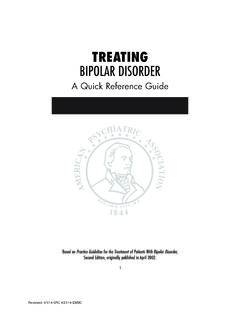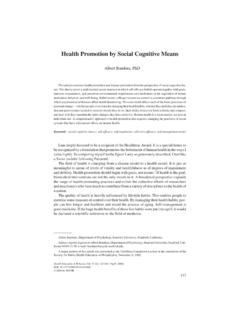Transcription of Promoting Children's emotional health a research review
1 Bart Essentials research review Promoting children s emotional health Rachel Smith, Policy, research and Influencing Unit September 2002 Picture by Samantha Seaton children s emotional health Why is emotional health important? health is the basis for a good quality of life and mental health is of overriding importance in this (Article 24 of the United Nations Convention on the Rights of the Child) PAGE 2 of 15 Bart Essentials There are approximately million children and young people under 20 living in the UK, representing 25% of the population.
2 A substantial minority of children up to 45% - are likely to experience moderate or severe psychological problems at some point in childhood or early adulthood. It is suggested that at any one time, up to 20% of children and young people may be affected by emotional and behavioural problems, most commonly anxiety disorders, disruptive disorders and attention deficit hyperactivity disorder (Buchanan, A., 1999, ). While a large proportion of children will recover without any need for specialist help, a worrying continuity has been observed between childhood problems and adult outcomes, particularly where no effective interventions have been offered. Without intervention, the possible consequences of emotional and behavioural difficulties are as follows: 1. Consequences in childhood Poorer family relationships Lower levels of school achievement Greater risk of school suspension/expulsion Links with offending behaviour Fewer qualifications Poorer employment prospects Social exclusion 2.
3 Consequences in adulthood Poorer relationships with partners and own children Links with mental health problems in adult life Possible links with a range of serious physical illnesses (Buchanan, A., 1999, ) Risk and protection factors Longitudinal studies in the UK, USA and elsewhere in the Western world show that a range of factors in children s early lives have been consistently associated with increased risk of mental health problems in adolescence and adulthood (MHF, 1999, p7). The greater the number of risks, and the more severe the risks, the greater the likelihood of the child developing a mental health problem. If a child has only one risk factor in their life, their risk of developing a mental health problem has been defined as being 1-2%. However, with three risk factors the likelihood increases to 8%; and with four or more risk factors the likelihood of the child developing a mental health problem is increased to 20% (MHF, 1999, p7). Evidence suggests that children s emotional well-being can improved if the number of risk factors is reduced, and the number of protective factors is increased.
4 PAGE 3 of 15 Bart Essentials A central finding in the literature on psychosocial adversities is that some individuals are more resilient than others. There are children who, against all odds survive intact and develop into competent, confident and caring adults despite prolonged and negative experiences. An important key to Promoting children s mental health is, therefore, a greater understanding of these protective factors that enable some children to be resilient (MHF, 1999, ). There is a broad consensus that factors that can promote childhood resilience are located in the following domains: The physical and emotional attributes of the child The child s family The immediate environment in which the child lives Intervening effectively yields huge benefits in reducing a number of problems that are of concern to government, school, parents and children (Mental health Foundation, 1999, ).
5 Table 1: Key risk and Protection factors for emotional and behavioural problems (Buchanan, A. & Ten Brinke, , 1998; The Mental health Foundation, 1999) Risk factors Protective factors Factors in the Person Genetic factors making the children more vulnerable to emotional and behavioural problems Temperament Impulsiveness Physical illness/impairment Mental disabilities Communication difficulty Low self-esteem Biological resilience Good health and development Good problem solving skills/ IQ Being female Secure attachment Good communication skills Humour / religious faith Belief in control Factors in the Family Family adversities Poverty Mental illness in the parents Alcoholism, criminality Conflict with and between parents Good relationship with parents Affection Supportive grandparents Lack of domestic tensions Family involvement in activities PAGE 4 of 15 Bart Essentials Lax, inconsistent discipline Punitive, authoritarian/inflexible parenting Death and loss Physical, sexual &/or emotional abuse Being brought up by birth family Factors in the school/ community Poor reading/low school attainment Bullying in schools Disadvantaged community/ neighbourhood crime Racial tension/harassment An experience of public care Supportive community Schools with good rates of achievement, good ethos.
6 Lack of bullying Opportunities for involvement and achievement Good housing High standard of living Range of positive sport/leisure activities Factors in the wider world Economic recession Unemployment Housing shortage Family change: increasing Family breakdown Long working hours/ job insecurity Inclusive policies Which children comprise the key target population? Specific groups of young people are at higher risk from developing emotional and behavioural disorders: children whose parents are divorcing A minority of children experience long-term psychological problems following divorce. The worst outcomes are likely to occur when the break-up is surrounded by conflict. PAGE 5 of 15 Bart Essentials children living with parental mental illness It is thought that between five and seven million adults are suffering from mental illness at any one time, and 30% of these will have dependent children (0-18 years old).
7 Although some parents with mental health problems can adequately care for their children , all such children are at risk of emotional and behavioural problems and some are at risk of significant harm. children who run away from home It is estimated that 43,000 young people ran away in England and Scotland in 1990. Most are aged between 14-17, but 7% are aged 11 or less. These young people are at risk as victims of crime and at risk of committing crime. children living with domestic violence Exposure to discord and hostility between parents is an important determinant of emotional and behavioural problems in children ; especially if the discord is persistent over time and the child becomes embroiled in hostility between the parents. children in care More than one in four children who have been in care have significant levels of maladjustment (Buchanan & Ten Brinke, 1997). research in Oxfordshire in 1998 found 67 per cent of those in the care system and 96 per cent of those in children s homes and secure units have clinical levels of psychiatric illness (McCann, James, Wilson & Dunn, 1996).
8 Young offenders Young prisoners are one of the most excluded and most needy groups in society. There are currently more than 11,500 young people aged 15-20 in jail. Of these, 90 per cent have a diagnosable mental illness, substance abuse problem, or both (Lyon, Dennison & Wilson, 2000). They are 13 times more likely than other children to be looked after by their local authority, and 20 times more likely to have been excluded from school. Rather than resolving the difficulties of these young people, prison often compounds their problems (Lyon, J., 2002). Within two years of their release, three-quarters will have re-convicted and 47 per cent will be back in jail (Social Exclusion Unit, 2002). What interventions work? This section describes factors and interventions associated with the promotion of resilience in the period of first school entry, to early adolescence and entry to secondary education. PAGE 6 of 15 Bart Essentials children s emotional well-being can be improved by reducing the number of risk factors, particularly family difficulties, and increasing the number of protective factors.
9 All protective strategies operate through one or more of the following processes: By altering the child s perceptions of, or exposure to risk By reducing the chain reaction that takes place when risk factors compound each other and multiply By helping the child improve self-esteem and self-efficacy By creating opportunities for change General factors Promoting resilience in the middle years Valuing and tolerating different cultural characteristics during the school entry period. Positive school experiences: academic, sports or friendship related. Good and mutually trusting relationships with teachers. Provision of breakfast and after-school clubs. Good home school liaison arrangements, and where necessary on-going home-school links, where parents lack confidence in their parenting ability or are disengaged from the educational process. In situations of marital discord, attachment to one parent, moderation of parental disharmony and opportunities to play a positive role in the family.
10 In abusive settings, the opportunity to maintain or develop attachments to the non-abusive parent, other family member, or failing these, a reliable unrelated adult; maintenance of family routines and rituals. Manageable contributions to the household which promote competencies, self-esteem and problem-solving coping. Stable accommodation. Community based initiatives that help to build social capital. The development of skills, opportunities for independence, and mastery of tasks. Structured routines and a perception by the child that praise and sanctions are being administered fairly. Help to resolve minor but chronic stressors as well as acute adversities. Encouragement to develop or adopt positive cognitive styles of thinking. Active support from external sources, including mentors, where children are at risk of developing patterns of anti-social or criminal behaviour. (Newman, T., 2002) PAGE 7 of 15 Bart Essentials Evidence suggests that it is easier to change a younger child s behaviour than the behaviour of an older child, however, at present there are far fewer well-validated programmes for older children .

















